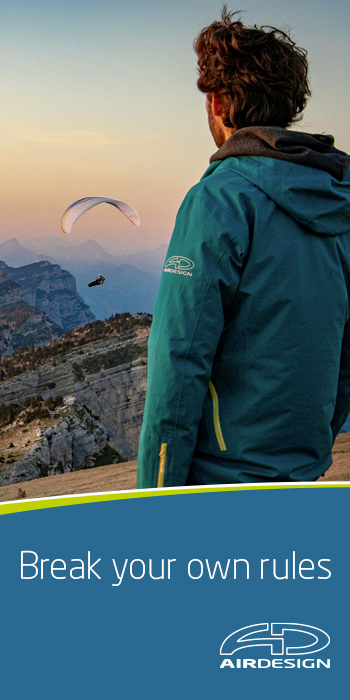TIPS ON HOW TO BECOME A BETTER PILOT!
Paragliding Master Tips are a series of articles designed to improve existing skills and techniques as well as help learn new ones. Intended for the beginner to intermediate pilot, these tips and tricks are offered as guidelines from some of paragliding’s most knowledgeable pilots.
Emma Casanova

4 – The Forward or “Alpine” Launch
The forward or alpine launch is often thought of as hard to grasp because of not being able to see the canopy as it rises off the ground. Pilots can often be seen on foreign launches in nil or weak wind conditions ungainly running backwards before spinning round in reverse launch mode to get off the hill! Somewhat gawky but also dangerous because of the possibility of tripping or losing balance and falling backwards down the hill.
In Europe, particularly in France, Switzerland and Germany, the forward launch is widely used and is in some cases the only launch technique taught in continental flying schools. With practice the forward launch technique will enable you to launch in light or nil-wind conditions or from a steep slope with confidence.
Improved glider characteristics make launching easier
Launching modern gliders has been made easier over the years due to improved glider design, and if you have been flying for a while, you too may need to review some of your old habits. A classic example of how techniques have changed in the case of the forward launch, is the correct hand and arm position to adopt. Whereby in the past we were taught to hold our arms and hands behind and below the body to forward launch, today the arms are held to the side and hands at shoulder height! This shows us that techniques also evolving with modern glider technology.
Here are a few key factors for preparing for a successful forward launch
Prepare your glider directly into wind in a symmetrical arc, which will enable the centre section to inflate before the tips.
Make sure all your lines are and untangled and separated from one another. Start by running your ringers through the A’s, the brakes and then the other lines.
Check the lines for any foreign objects such as grass or twigs.
Have your lines laid out on the ground so they are clearly visible of knots, separating the brake line in an arc shape away from the others.
After your final pre-flight checks, clip into your harness and stand with your back to the canopy. Hold the controls as you normally would in each hand and move forward to position yourself in the centre of the glider whilst gently tensioning the lines slightly off the ground behind you.

Hold the rises at the top near the maillons, lightly, but holding them vertically straight so they are taut from the connecting karabiner to your hands. In your peripheral vision you should just be able to see your hands holding the risers in an upright position at shoulder height.
The pace of your inflation will be dictated by the strength of the wind that you are launching into. Bearing this in mind, for light winds set up with just a small amount of slack in the lines by taking a small step backwards towards the wing. When you are ready, make a progressive but positive stride into the wind keeping the risers evenly tensioned and vertical as you push your bodyweight forwards to raise the canopy off the ground.

Use your senses
Try to feel when the glider is almost above your head, then release the rises and apply a small amount of break. This will allow you to synchronise your own ground speed with that of the glider as well as making any directional adjustments whilst keeping the lines of the glider tensioned. In this way, you will be able to move forwards and diagonally with the pull of the wing. Any diagonal movement can be countered by applying enough opposite brake until the wing is centred above your head. Then and only then can you increase your ground speed and push your body through the risers to launch.

More wind – more conviction
In stronger wind conditions, but no more than for the use of an effective reverse launch, when standing with your back to the canopy with the lines tensioned, take one step back so that when you are ready to inflate you can do this with conviction, using all your body weight through the harness and a confident stride. The glider will inflate quicker in stronger winds and will start to pull you backwards. In the beginning of this phase you will need to resist the tension but then allow yourself to be pulled back a couple of steps, and at this point, the glider will rise to the central point above you with minimum effort. This is where you need to be active in preventing the glider from overflying you by applying brake.
Try to feel the position of the glider over your head at all times. This will take some practice but feeling the glider’s movements rather than craning your neck to look at the canopy will enable you to act quickly. Your control will be improved through perfect timing using your body movements and the right amount of brake pressure.

Some key points to remember are
1. Assess the conditions and be progressive with your launch strides.
2. Recognise and act on any directional deviations by feel.
3. Control the glider to your pace and be prepared to move diagonally as well as forwards.
4. Only when the glider is positioned symmetrically above your head and you are ready to launch should you push your full body weight through the risers.
TROUBLE-SHOOTING
If your glider has a higher aspect ratio, try holding only the centre A-lines just above the maillons. This will ensure the centre of the glider comes up before the tips avoiding any wobbling or “clapping” effect.
If the glider comes up and off to one side, this can be for several reasons: your glider is not parallel to the slope, there is a slight wind off to one side, you have not positioned your body to the centre of the wing. Take time to properly prepare your glider first before inflating.
When correcting your diagonal direction, it is important not to fight the “pull” of the wing. Go with it and whilst moving yourself under the canopy, apply the opposite brake to keep the lines tensioned and steer in the direction you want to go.


